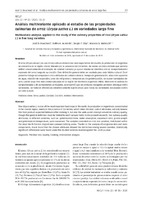Análisis multivariante aplicado al estudio de las propiedades culinarias de arroz (Oryza sativa L.) en variedades largo fino
Multivariate analysis applied to the study of the culinary properties of rice (Oryza sativa L.) in fine long varieties
Date
2020-06-25Author
Bouchard, José Daniel
Acevedo, Belén Andrea
Díaz, Sergio Fernando
Maiocchi, Marcos Gabriel
Metadata
Show full item recordAbstract
El arroz (Oryza sativa L.) es uno de los cultivos alimenticios más importantes del mundo, la producción en Argentina se concentra en la región Litoral, liderada por la provincia de Corrientes. No existe un único atributo que permita definir universalmente el concepto de calidad culinaria ya que el mismo se identifica con el comportamiento esperado del arroz luego de su cocción. Esta definición general debe ser acotada para cada hábito cultural. En el presente trabajo se compararon cinco atributos de calidad culinaria: tiempo de gelatinización, absorción aparente de agua, relación de expansión, peso de mil granos y temperatura de gelatinización, en nueve variedades de arroz pulido largo fino más comercializadas en la región del Nordeste Argentino (NEA). Mediante el análisis den conglomerados y de componentes principales, se encontró que los atributos escogidos permiten distinguir entre variedades. Se hallaron diferencias estadísticamente significativas para todas las variedades estudiadas contra un valor p<0,05. Rice (Oryza sativa L.) is one of the most important food crops in the world. Its production in Argentina is concentrated in the coastal region, mainly in the province of Corrientes, which takes the lead. Lack of attributes, not only lessens this food product expected behavior after cooking it, but also the wide-world concept around its culinary quality; though this general definition must be limited to each cultural habit. In the present research, five culinary quality attributes, in different variables, such as: gelatinization time, water absorption, expansion ratio, grains weight and gelatinization temperature, were examined. The samples consisted on nine rice varieties, distributed within the most North-Eastern Argentinian commercializing areas. Thanks to the analysis of conglomerates and main components, it was found that the chosen attributes allowed the distinction among several varieties. Statistically significant differences were found under the studied varieties studied against the <0.05 p-value.
URI
https://hdl.handle.net/20.500.12219/2599https://doi.org/10.36995/j.recyt.2020.33.005
https://www.fceqyn.unam.edu.ar/recyt/index.php/recyt/article/view/269
Collections
The following license files are associated with this item:




